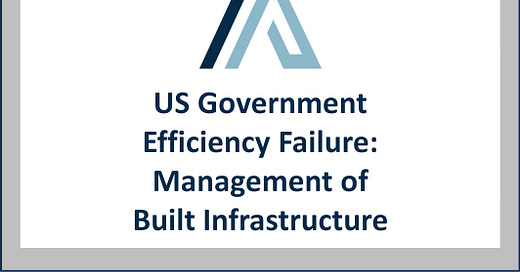A Call to Action - GAO
US Government Efficiency Solution for Real Property Management Miniseries
The article outlines a critical issue: the U.S. government’s persistent failure to efficiently manage its vast built infrastructure, as highlighted by the National Academies’ Strategies to Renew Federal Facilities (2023) and numerous Government Accountability Office (GAO) reports. Below is a summary of the key points and a call to action related to GAO’s role in addressing this systemic problem.
GAO’s Role and Strengths
Purpose: GAO, as Congress’s independent, non-partisan “watchdog,” evaluates federal spending and performance, providing objective, fact-based reports to improve efficiency and save taxpayer dollars.
Key Products: GAO produces influential guidance like the Standards for Internal Control (Green Book), Cost Estimating and Assessment Guide, and Schedule Assessment Guide. Its High Risk List, updated biennially, identifies critical issues, including federal real property management (high-risk since 1997 for DoD, 2003 for all agencies).
Real Property Focus: GAO’s 2025 High Risk List notes progress and regressions in real property utilization, data reliability, facility security, and building condition (re-added in 2025). It includes 58 open recommendations, but these are seen as insufficient to address root causes.
The Problem
Chronic Underfunding: GAO reports consistently highlight symptoms—poor utilization, unreliable data, and growing deferred maintenance and repair (DM&R) backlogs—but often stop short of addressing systemic causes.
Solution Recommendations: the National Academies’ Report: Strategies to Renew Federal Facilities (2023) identifies the root cause as a systemic management system failure, not a lack of resources, policy, or will. It leverages over 60 GAO reports, including GAO-19-57 on leading practices, to propose five actionable recommendations.
National Academies’ Recommendations (GAO Call to Action Lens)
Emphasize Use of Agency Real Property Asset Management Systems:
Agencies must align real property management with OMB directives (e.g., Circulars A-11, A-123) to link mission objectives, budgets, and performance.
GAO should evaluate whether agencies implement these requirements in policy and practice, ensuring budgets achieve strategic goals.
The National Academies found that most of what is needed is already in OMB directives and guidance, but it is not being used or implemented correctly. GAO has an obligation to evaluate application of policy issues identified in Strategies to Renew Federal Facilities at the agency level.
Improve Agency Real Property Capital Plans:
OMB’s Circular A-11 Capital Programming Guide, Circular A-123, and M-20-03 require linking mission objectives to budgets and real property programs, but gaps persist.
GAO should scrutinize how agencies address enterprise risk management (Circular A-123) to address best use of limited real property funding to achieve agency mission objectives more so than issues like DM&R backlogs.
Enhance Agency Real Property Strategies:
Agencies need strategies aligned with OMB M-20-10 and the Government Performance and Results Act (A-11, Part 6).
GAO should assess if real property deficiencies are prioritized as “Agency Priority Goals” to demonstrate leadership commitment. These strategies go beyond budget justification; they make leadership commitments to the achievement of stated objectives.
Improve Models, Data, and Measures:
Current DM&R reporting is a lagging indicator; predictive models are needed (GAO-14-105485) and National Academy reports Predicting Outcomes of Investment in Maintenance and Repair of Federal Facilities and Strategies to Renew Federal Facilities.
GAO should investigate why agency data and models are “nonconsequential” to decision-making, as detailed in Strategies to Renew Federal Facilities (Chapters 2–4, Appendices E–F).
Enhance Budget Development and Expenditures:
Legislation like the Federal Asset Sales and Transfer Act (FASTA) and innovative funding models (e.g., revolving funds, working capital funds, and user-pay models) can incentivize better decisions.
GAO should emphasize economic decision-making principles (beyond Circulars A-94, A-123, and the GAO Green Book) to hold agencies accountable for fiduciary responsibilities.
Call to Action for GAO
This article argues that GAO’s approach, while rigorous, often “admires the problem” by focusing on symptoms rather than root causes. To drive systemic change:
Update Guidance: GAO’s Determining Performance and Accountability Challenges and High Risks (GAO-01-159SP) is outdated (2001). It should incorporate modern technology, data analytics, and management systems, including AI-driven enterprise solutions. A prerequisite to all of this federal agency improvement of their management systems, which is the first of the five recommendations contained in Strategies to Renew Federal Facilities.
Focus on Asset Management Systems: GAO should evaluate the capability of agency real property asset management systems, using frameworks like ISO 55000 and GAO-19-57. This aligns with the National Academies’ call for disciplined asset management to address systemic failures.
Push for Accountability: GAO should hold agencies accountable for nonconsequential decision-making and data use, ensuring real property management aligns with mission objectives and fiduciary duties. This strikes right at the heart of objectives detailed in OMB Circulars A-123 and A-136, and the GAO’s Green Book.
Conclusion – Call to Action
GAO’s work is foundational, but its impact can be amplified by shifting focus from symptom-based reporting to systemic solutions. By adopting the National Academies’ recommendations, updating its high-risk evaluation criteria, and prioritizing asset management system assessments, GAO can drive meaningful reform. This requires evaluating not just what agencies do but how their systems enable effective decision-making. Integrating modern tools (e.g., predictive analytics, AI) and frameworks like ISO 55000 into GAO’s audits will address the root cause: a lack of disciplined, systemic asset management. This call to action aligns with GAO’s mission to improve federal efficiency and save taxpayer dollars, ensuring the government’s $1.7 trillion real property portfolio is managed effectively.
Written by Jack Dempsey | July 1, 2025
AMP Newsletter #128
Copyright © 2025, Asset Management Partnership LLC




